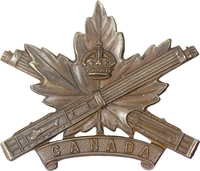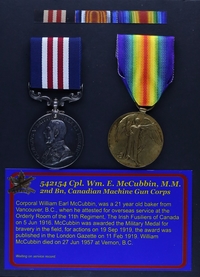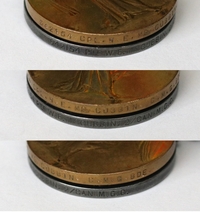
542152 Cpl William Earl McCubbin, M.M.
3rd Division Cyclist Company
2nd Battalion, Canadian Machine Gun Corps
By: Capt (ret'd) Michael M. O'Leary, CD, The RCR
William Earl McCubbin was born in Vancouver, B.C., on 21 Mar 1895. McCubbin's family, led by parents Ira and Minnie, can be found in the 1901 and 1911 Canadian Censuses. The two appearances of the family, although there are differences in the recording and transcription of names, shows that William is the third child, and the second son, of five offspring: Alvah (b. 1891); Ethel (b. 1892); William (b. 1895); Myrtle (b. 1900); Alva (b. 1910). Alvah would also serve in uniform during the Great War.
First enlisting with the 11th Regiment, The Irish Fusiliers of Canada, at Vancouver, B.C., on 5 Jun 1916, McCubbin was given the regimental number 3847. Immediately on joining this Militia regiment, he also completed an Attestation Form for the Canadian Expeditionary Force (C.E.F.), attesting for service in the 3rd Division Cyclist Company on the same date. A 21 year old baker, McCubbin was described on his attestation paper as 5 feet 5 inches tall, weighing 142 pounds, with a 36 1/2-inch chest, a fair complexion, blue eyes, and light brown hair. His religious denomination was Methodist. McCubbin identified his mother, Minnie McCubbin, 31 Fifteenth Ave. E., Vancouver, B.C., as his next of kin. On attesting with the 3rd Div Cyclists, McCubbin was given the regimental number 542154.
While McCubbin was training for overseas, his father, Ira Case McCubbin, died at Vancouver on 30 Oct 1916. (Minnie would survive her husband and die in 1935.) After his father's death, William McCubbin supported his widowed mother and had already initiated a monthly Pay Assignment in October, 1916. This would send $15 each month to his mother, which was about half of his pay as a Private. Mrs. McCubbin, as a widow who would be supported by her sons during the war, would also receive $20 monthly Separation Allowance after her husband's death. These payments together were still less than the $60 per month that McCubbin declared he had been providing her before enlisting. The amount of the Separation Allowance paid each month would increase to $25 on 1 Dec 1917, and then to $30 on 1 Sep 1918.
His training in Canada completed, McCubbin embarked at Halifax, N.S., aboard the S.S. Scandinavian, on 24 Jan 1917. He disembarked at Liverpool, Eng., on 6 Feb 1917 and the following day was taken on strength of the Canadian Reserve Cyclist Company at Chiseldon on 7 Feb 1917. he would spend the spring and summer of 1917 at Chiseldon, but the requirement for Cyclist reinforcements was not enough to take him overseas to France.
On 10 Sep 1917, McCubbin left the Cyclist Corps and was transferred to the Canadian Machine Gun Depot at Shoreham. After another two months, he finally joined a draft for France and on 14 Nov 1917 he was transferred to the Canadian Machine Gun Pool, Overseas. Arriving at the C.M.G. Pool at Camiers the following day, he would only wait four more days before being posted to the 14th Machine Gun Company.
Each infantry brigade in the C.E.F. formed a machine gun company in December, 1915. These companies were numbered to match their parent brigades and those of the 2nd Canadian Division were the 4th, 5th, and 6th Canadian Machine Gun Companies. In January, 1917, a divisional machine gun company was created in each division. The 2nd Division's company, titled the 14th Machine Gun Company, was organized at Floringhem, Belgium, in January 1917 by drawing personnel from the 4th and 5th Cdn. M.G. Companies and from the Machine Gun Pool. Each M.G. company fielded 16 Vickers machine guns in support of its brigade or division.
William McCubbin joined the 14th M.G. Coy. on 20 Nov 1917, one of a draft of 20 soldiers who reported to the unit that day. Like the infantry battalions of the Canadian Corps, the M.G. Companies also cycled between front line positions, reserve positions, and static camps for periods of rest filled by days of training. The War Diary entry for 4 Mar 1918 described an active day in the front lines for the company:
"4/3/18 — Weather:— Wet & misty. At 5.55 a.m. enemy put down a very heavy barrage on our forward area. Fire was opened by all guns laid on S.O.S. lines. Enemy barrage continued for about an hour, when situation again became normal. During the barrage a total of 32,700 rounds was fired by all guns. No. 6 gun at M.30.b.60.35 was hit by shrapnel and put out of action. Gun position at M.24.b.95.70 was blown in by a shell and two men were buried and badly bruised but gun was kept in action. During the night the Company was relieved by the 4th C.M.G.C. and returned to billets at CARENCY. Relief was uninterrupted by hostile activity."
The next few days in billets emphasizes the sudden change from the front line environment to the rear areas, and also the prioritization of tasks:
"5/3/18 — Weather:— Dull. Company engaged in cleaning guns and gun equipment.
"6/3/18 — Weather:— Fine. Company engaged in cleaning personal equipment.
"7/3/18 — Weather:— Fine. Inspections of guns and gun equipment by O.C."
A Library and Archives Canada document outlines the evolution of the machine gun units of the Canadian Corps in late 1917 and early 1918:
"The 4th, 5th and 6th Cdn. M.G. Companies were detached from their respective infantry brigades in September 1917 and, with the 14th Cdn. M.G. Company, formed the 4th, 5th, 6th and 14th Companies of the 2nd Canadian Divisional M.G. Battalion. Reorganized on 21 March 1918 to form the 2nd Battalion, Canadian M.G. Corps."
On 19 Mar 1918, McCubbin was transferred to the Canadian Machine Gun Corps (C.M.G.C.) as the 2nd Cdn. Div M.G. Bn. becomes the newly organized 2nd Battalion, C.M.G.C.
From 18 to 24 March 1918, the Battalion was training at Marqueffles Farm near Bouvigny. The 14th Company section of the training syllabus details the training conducted to maintain skills of new and old soldiers in the unit:
- March 18th — a.m. Squad drill; Lecture "Discipline & Compliments" at 11.15 a.m. Stripping & Nomenclature of parts; Nomenclature of spare parts; Gun Drill. P.M. Recreation.
- March 19th — a.m. Manual of Arms; Lecture 11.15 a.m. "Allocation of Duties"; Nomenclature of spare parts; Mechanism; Immediate action; P.M. Recreation.
- March 20th — Duty Company.
- March 21st — a.m. Squad Drill with arms; Lecture "Reliefs & Sentry Orders' Mechanism; Immediate action; Gun Drill; 3.00 P.M. Lecture TANKS by Lt.-Col. F.H. Fernie, O.C. 7th Tank Bn.
- March 22nd — a.m. Squad Drill; Lecture 10.30 a.m. "Reference Objects and use of Traversing and Elevating Dials"; Gun Drill (Gas helmets adjusted); Packing Limbers. p.m. Route March 1 ½ hours.
- March 23rd — a.m. Indirect Fire Range; p.m. Recreation.
- March 24th — Duty Company
- NOTE:— P.T. 7.30 — 8.00 a.m.; Gas Helmet Drill 8.00 — 8.30 a.m.; Company Parade 8.45 a.m.; Battalion Parade 9.00 a.m. This routine to be carried out daily.
- [Training to be conducted] 5 hours daily 7.30 a.m. - 12.30 p.m. Bath parades etc., outside Training hours.
- N.C.Os' class daily 1.30 p.m. - 3 p.m. as per Company schedule
- Gas Drill to be Progressive as follows:—
- 1st half hour — Adjusting S.B.R. [i.e., Small Box Respirator] by numbers; cleaning eyepieces.
- 2nd half hour — Speaking with S.B.R. adjusted; practice in giving orders.
- 3rd half hour — Method of clearing mask from gas. How to test whether Trench or Dug-out is clear of gas.
- 4th half hour — Quick adjustment of S.B.R. (steel helmets to be worn and rifles carried).
The summer of 1918 saw the 2nd Bn., C.M.G.C., in and out of the front lines. The unit's War Diary entry for 6 Aug 1918 foretells the war's final campaign, Canada's 100 Days:
LONGEAU — August 6th, 1918 — Today Operation Order No. 103 was issued and it made plain all the usual preparations and bustle were not without meaning. The Canadian Corps were at last, after half a year's comparative inactivity, to attack. The 2nd Canadian Division was to be the left division of the Corps with the 1st Canadian Division and the 2nd Australian Division on its right and left flanks respectively. Cavalry and Tanks were also to be used in large numbers. The objectives were marked on a sketch attached thereto and shown as GREEN, RED and BLUE lines respectively. The object of the attack was expressed to be for the purpose of freeing the PARIS-AMIENS Railway.
Thus started the 100 Days for the 2nd Bn., C.M.G.C. and for McCubbin. The unit's War Diary details the very active battlefields of the following months. Unfortunately, few individual actions were captured by the diary, despite the new challenges of open warfare and the demands for initiative on the part of young officers and non-commissioned officers.
On 5 Oct 1918, Norman McCubbin was promoted to the rank of Corporal. The following month, on 2 Nov 1918, he was granted 14 days leave to the UK, which would coincidentally make him miss the war's final days at the front.
Soon after his return to the unit, the results of McCubbin's visit to the UK during the Armistice celebrations caught up to him. On 27 Nov 1918, he as admitted to 14 Canadian Field Ambulance suffering from "V.D.G.," i.e., venereal disease, gonorrhea. A simple note in his file identified the place and time of contracting his affliction; "London, Nov." Three days later, on 30 Nov 1918, McCubbin was evacuated on No. 30 Ambulance Train and admitted to No. 51 General Hospital at Etaples on 1 Dec 1918. He was hospitalized until 1 Feb 1919 (63 days) and while he was in hospital for this self-inflicted cause, he was required to forfeit his Field Allowance and 50 cents of his daily pay.
On 1 Feb 1919, McCubbin was admitted to No. 7 Canadian Stationary Hospital, Camiers, and also attached to the Canadian General Base Depot. McCubbin continued rearward movements, to the M.G. Corps Depot at Seaford 8 Mar 1919 and then to Military District No. 11 Wing at Rhyl on 25 Apr 1919 in preparation for return to Canada.
As he moved between these holding units, the London Gazette issue No. 31173 was published on 11 Feb 1919, announcing the award of the Military Medal to "542154 Pte. McCubbin, W.E., 2nd Bn., Can. M.G.C."
Norman McCubbin embarked at Liverpool, Eng., aboard the S.S. Celtic on 7 May 1919. As he sailed from England's shores, he was taken on the strength of No. 11 District Depot on 7 May 1919.
McCubbin was discharged from the C.E.F. at Vancouver, B.C., on 21 May 1919. He was entitled to a War Service Gratuity of $350. This was paid to him in installments between May and September 1919. For his service in the C.E.F., McCubbin was entitled to receive the British War Medal and the Victory Medal. These were despatched to him at 529 11th St. East, Vancouver, B.C., on 12 Oct 1921.
On 7 Aug 1923, at the age of 27, William McCubbin married 25-year-old Mary Helena Ward. The wedding took place at Vancouver, B.C. the couple would have one child, William Donald McCubbin (1925-2016).
William Earl McCubbin died at Vancouver on 27 Jan 1957 at the age of 61. The cause of his death was recorded as acute myocardial infarction resulting from coronary thrombosis, and years of atherosclerosis and hypertension. He would be buried three days later in Vernon, B.C. McCubbin's death register notes his trade as farmer, and that he had done that work for six years before retiring in 1953. Mary McCubbin would live another 31 years after her husband's death, She died at Vernon, B.C. on 7 Mar 1988 at the age of 90.
Pro Patria
Visit a randomly selected page in The O'Leary Collection (or reload for another choice):
- The O'Leary Collection; Medals of The Royal Canadian Regiment.
- Researching Canadian Soldiers of the First World War
- Researching The Royal Canadian Regiment
- The RCR in the First World War
- Badges of The RCR
- The Senior Subaltern
- The Minute Book (blog)
- Rogue Papers
- Tactical Primers
- The Regimental Library
- Battle Honours
- Perpetuation of the CEF
- A Miscellany
- Quotes
- The Frontenac Times
- Site Map
QUICK LINKS
The O'Leary Collection—Medals of The Royal Canadian Regiment
Newest additions:
![]()
![]() SB-12725 Private Henry "Hank" Ard
SB-12725 Private Henry "Hank" Ard ![]()
WIA at Hill 187, Died of Wounds in Japan
![]()
![]() 2355331 Lance Corporal Albert Lorking
2355331 Lance Corporal Albert Lorking
Wounded in action, later a War Amps representative.
![]()
![]() 4334 / 477996 Pte Isaac Hamilton Wilcox
4334 / 477996 Pte Isaac Hamilton Wilcox
Permanent Force, South Africa, and C.E.F.
![]()
![]() 477019 Private Harold Ashcroft
477019 Private Harold Ashcroft
Transferred to the Tunnelers.
![]()
![]() 734231 Private Clark D. Thompson
734231 Private Clark D. Thompson ![]()
The older Thompson brother, killed in action.
![]()
![]() 733849 Private Norman Parker Thompson
733849 Private Norman Parker Thompson
The younger Thompson brother; post-war service in the Special Guard.
![]()
![]()
![]() A305 / 400305 Private Andrew Walker
A305 / 400305 Private Andrew Walker ![]()
"Previously reported Wounded, now Killed in Action."
![]()
![]() 823298 Pte Thomas Patrick Steele, M.M.
823298 Pte Thomas Patrick Steele, M.M. ![]()
… for gallant conduct in the field …
![]()
![]() P13066 Sergeant Harold Thompson
P13066 Sergeant Harold Thompson
Instrumental Soloist for over 20 years of Canadian Army service.
![]()
![]() 9609 / 477728 Private Albert Edward Piper
9609 / 477728 Private Albert Edward Piper
"Arrived from England as a STOWAWAY …"




